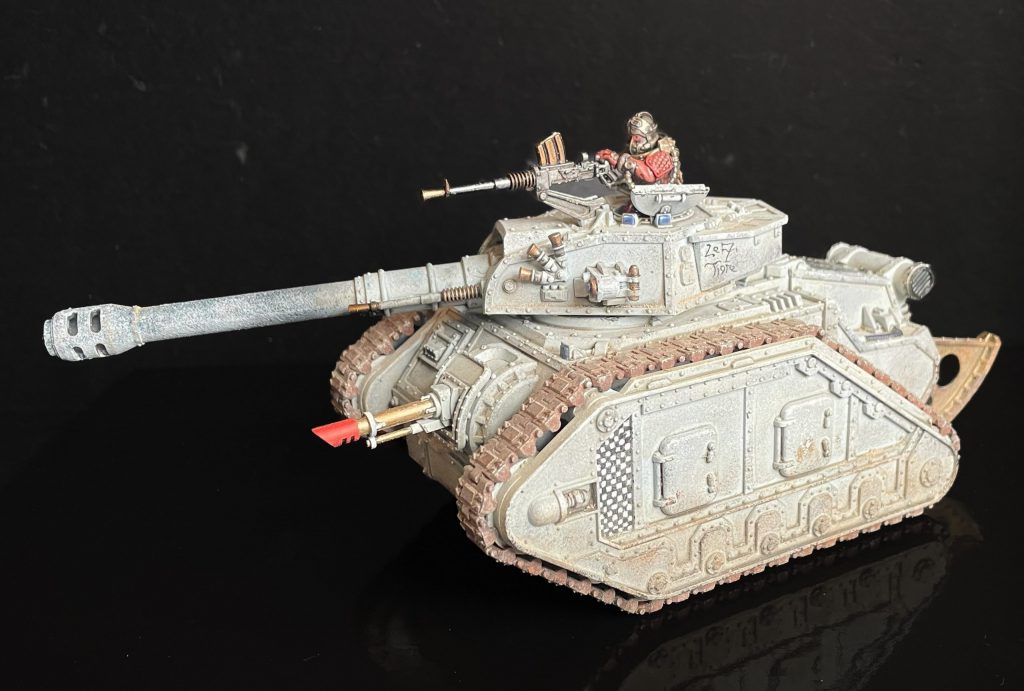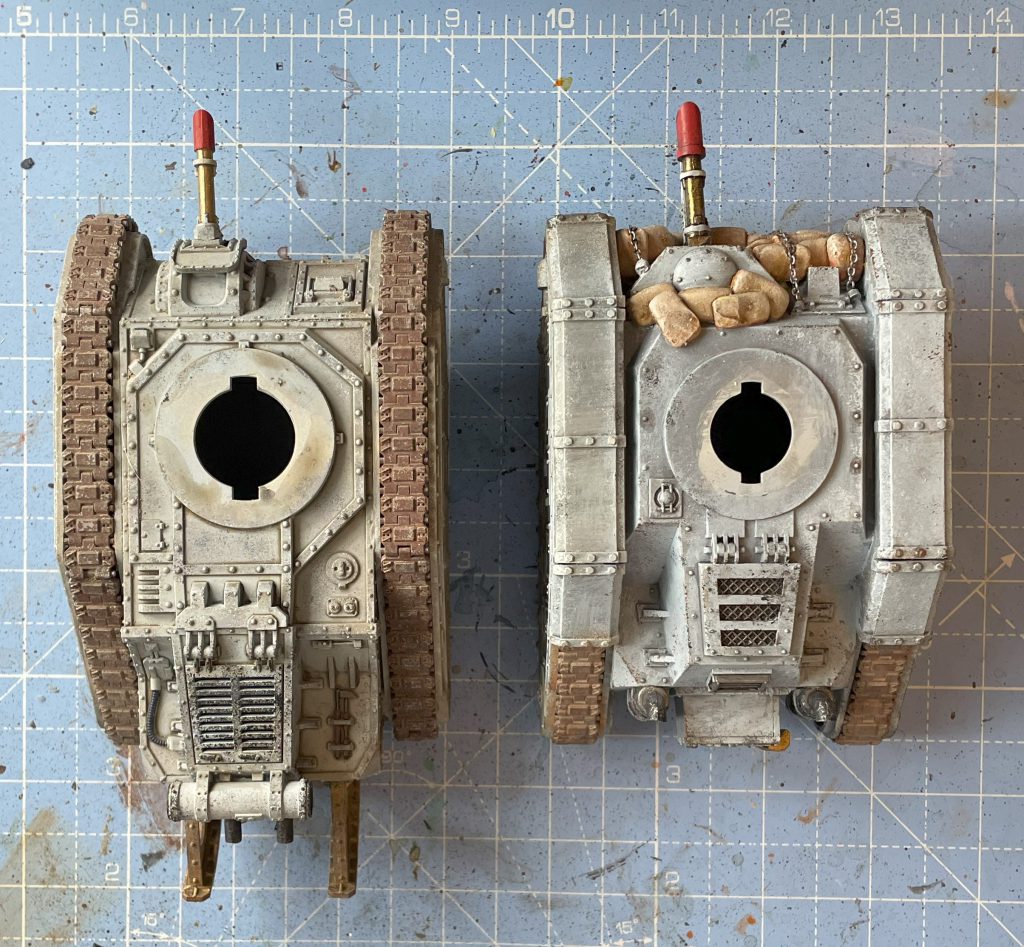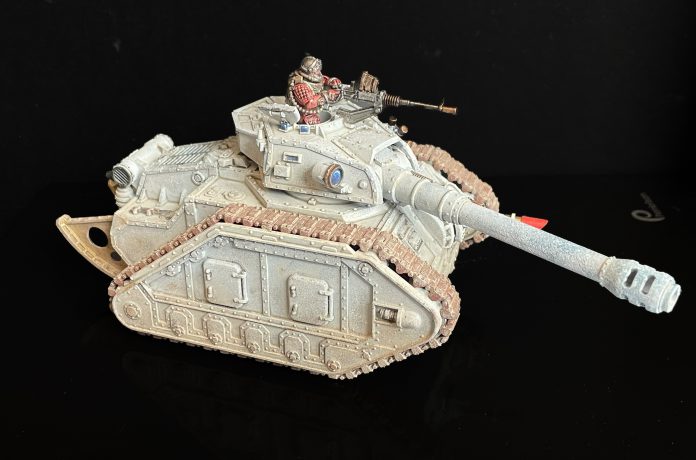I love a good Leman Russ. Back in 96 it was the first tank I ever bought, and some of the much-battered, often-restripped parts of that particular Russ has stayed with me to this day. So I was damn excited to get the Solar Auxilia Leman Russ Strike Tank, because the kit promises “the same tank, but cooler and older”, and guess what? It is.
Before diving in, thanks to GW for sending this kit over for review.
The Strike Tank kit is the Leman Russ we know and love, but upgraded, detailed and retooled for the modern era. It’s not just a significantly fancier Russ, but has picked up details and accessories once restricted to the Forge World resin versions of the tank, details that are a delight to paint and really perk up the venerable model. It’s sure to become a mainstay of the Solar Auxilia – so let’s get to talking about it.
Design
This is very clearly a Solar Auxilia tank, taking a lot of inspiration directly from the Forge World Resin (as you’d expect) and the longer lineage of Forge World Leman Russes, all the way back to the Baneblade. Changes to the casement weapon from the angular 40k version to the rounded, 30k version goes a long way to changing up the silhouette of the Russ to be more obviously 30k. It’s clearly been designed to provide a plastic version of the venerable Forge World conversion kits, the Mars and Ryza pattern Leman Russes clearly inspired the new plastic design. This extends to some of the odder choices – like the coaxial autocannon on the vanquisher cannon being identical to the heavy stubber on the pintle mount – so clearly “as close to the Kreig turret as you can” was the order of the day. When compared to the 40k Russ, every element is just a little different, building to a very distinct tank that is still immediately identifiable as a Leman Russ – and a Solar Auxilia one to boot.

The ubiquitous Solar Aux trim adds a lot of weight and a kind of brutal additional threat to the tank, as well as evoking even more of a WW1-1930s tank aesthetic. It’s heavily placed around edges, corners and through flat surfaces which really hammers home the dieselpunk vibe through a mix of design references from Dreadnoughts to Mark Vs and Whippets. There’s a ton of incidental and scene-setting detail too, from additional viewports to (albeit fiddly) small additional armour plates and plugs. I particularly like the “clearly intended for a smoke” small hatches and vents across the model. Some additional stowage is included (entrenching tools and axes), but I would have liked more. Perhaps that’s not in keeping with the cleaner lines of the Solar Auxilia compared to ragtag Imperial Army, but some sandbags, improvised armour and tank riders never go amiss, do they?
This isn’t just obviously a Solar Auxilia tank, it’s also clearly a 30k tank. The additional detail gives a much higher-tech look to the 30k than 40k russ – everything is a little brassier, more arcane, more reliant on high-future technology- while the sharper corners and huge number of rivets anchors it into an early Second World War aesthetic. Futuretech meets 1920-40? That’s the Heresy, alright.
Build
The build is trickier than the 40k Russ, with a lot more pieces for the same components. That means your muscle memory of decades of building the same tank will support you to get most of it done, but then it’s time to turn to the instructions. The hull is a good example. In the 40k Russ, it’s just Top and Bottom. In the Solar Aux Leman Russ we have 7 pieces, not counting the additional detail that plugs into recesses around the tank. Those extra components give much better – and nicer – detail to the tank, but they do require a lot more care than usual for modern GW tank sculpts. Virtually everything is intelligently keyed too, making snug fits for that fancy trim easy even on very sharp edges. You’ll need to pay even more attention to cleaning pieces after removing them from the sprue, but if you do then gap-filling should be minimal – I dont think I did a good job of it, so consider milliput rather than sprue glue.

The Strike Tank weapons are all on a single sprue that also contains a turret, so I would expect the support tank variant to come with a similar sprue to cover the remaining weapons with a new turret option for them. You could therefore just swap out turrets to build both tanks. Likewise, the upper section of the hull is on a separate sprue. Magnetising the turret weapons is not difficult, but not as simple as the 40k Leman Russ. There, the weapons all sat in the same bottom half so swaps were very easy. Here, the weapons are much more integrated into the turret, with well designed joints to enable movement. It’s not difficult to magnetise these though, and shaving off the ball of the join will let you get magnets in there. The front gun shield is high enough that you can slide weapons in under it and hide any obvious magnets.
One of the best bits about the Heresy tanks has been the Accessory sprue, the ubiquitous source of Fulmentarus bits and interesting heads for Space Marines. With the Solar Aux getting plastic tanks too, a Solar Aux accessory sprue has followed and it’s even better than the marine one. Three turret weapons, a Solar Auxilia commander (with two arm, head and hand options), a MASSIVE dozer blade and all the usual tank gribblies make it a fantastic set of accessories that I legit can’t wait to have several of. While the tank is (mostly) quite utilitarian, though fancy, the accessories sprue really crams in the gothic and the weird, with a lot of Age of Sigmar-Adjacent detail to ramp up the weirdness of the Solar Auxilia.

Strangely, a few of quality of life improvements made when the 40k Russ was re-done in the 2010s have vanished again here. The tracks are back to how they used to be in the 90s, much tricker to get looking right than the remodelled tracks, and the experience of looking at the instructions trying to count up links to see which piece was which after they’d been painted off the sprue was all too familiar. Here, and with some of the overlapping hull plating, copying the “new” 40k Russ would have been the way to go. It feels very much like someone based this on the 1994 Russ, which is a bit of an odd move, with many of the improvements in GW tank construction lost in the process.
40k Compatibility
The kit is clearly not designed to have cross-compatible components with the old Russ kit – and that’s fine. Conversion would be needed on most of the elements. For example, while they’re both roughly the same size, the hull of the heresy Russ is much longer – more akin to the old Forge World Mars Pattern, where this clearly borrows a lot of inspiration. The turret connection point is much wider in the Heresy variant, so hot-swapping turrets isn’t easy. The 40k turret will sit right on the 30k hull, but not vice versa and I think that’s probably deliberate. The slightly different shape of the front plate will also present a challenge, but I think if you’re planning on sprinkling Solar Aux Russ details into your plainer Russ components then you’re going to have more than enough experience to make it work.

The Leman Russ in the Heresy, whether Auxilia or Militia, hasn’t yet discovered how bloody useful sponsons are, so these are not part of the kit. Unlike the 40k Leman Russ, this has very clearly not been designed with sponsons in mind – and fair enough! – which may limit its utility to those of you looking for a fancier model for 40k. Careful attention with a dremel and file, and a little plasticard, would make adding sponsons, or magnetising for removable sponsons possible, but it will be a bit of work to make this look good. I think you could fit them in fairly far forward, if you trimmed either the Russ sponson or cut away at some of the detail of the track – but either way, this will be a careful process.
Painting
I decided to paint my Leman Russ to fit alongside my WW1 French inspired militia that will form a meat shield for the Solar Auxilia (themselves a meat shield for my Ultramarines). That meant a single colour for both panels and trim – a nice sky blue. This took a lot of colour from the Renault FT in the Bovington Tank Museum, and, I think, shows that you don’t need to go for the full contrasting trim to get a good result.
This is mostly sponged on, working up from a wraithbone base shaded with Basilicanum Grey. As always, there’s a little freehand, and the tank is named after the great Le Tigre. The transfer sheet is very nice – if monochrome – but I’m not a transfer guy, so freehand it was!

I paint tracks separately with a black undercoat and a brown base. A rust wash and then sponged metal gives a nice effect that’s quick to apply. Despite the immense pressure I feel in painting something for review, I managed to get some weathering powders and rust streaking on – more will come – to give the tank a lived in look.
Conclusion
This is a great kit with a few minor issues if you’re used to the easier build of the 40k Russ. The standard of tank modelling for Heresy vehicles is very high, and at first I wondered if we were going to get a rehashed version of the Russ for the Solar Auxilia. Instead, this is a complete rework in the style of the Forge World Russ variants, which is very, very cool. If you’re playing Heresy, get this tank. If you’re playing 40k, still get it, just prepare to do a little work to get those sponsons on. Overall a very strong showing for the Solar Auxilia – bring on more plastic tanks!
Questions, Comments, Suggestions? contact@goonhammer.com or leave a comment below




